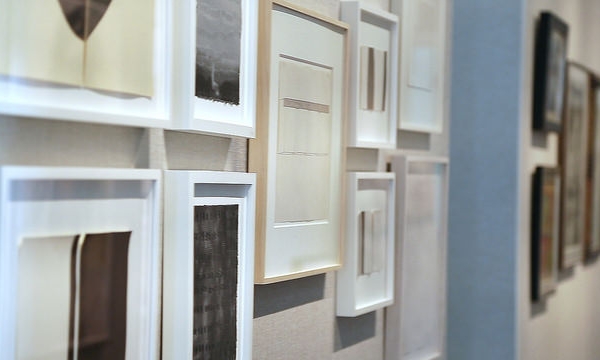Framing and displaying an artwork properly can help draw attention to a work, enhance its visual appeal, and keep it safe. Poorly framing or displaying a work of art, on the other hand, can lead to discoloration, fading, acid burn, and other severe and unnecessary damage.
The effects of acidic matting on a Picasso drawing.
Investing in high quality framing can help ensure that your artwork is better protected for the future. Proper framing and display borrows the knowledge and strategies of conservators, who dedicate their lives to preserving the integrity of art. Therefore, the commonly used phrase is “conservation-grade” framing (“museum-grade” is synonymous).
A Jean Dubuffet in a standard frame.
A Jean Dubuffet in a custom-made, conservation-grade frame.
We asked our Custom Frame and Fabrication (CFF) Department heads, Kelly Reynolds and Molly Maguire, about the importance of conservation-grade framing and display. Molly said, “When framers can consult with the conservators in real-time, it ensures that the methods and materials are safe for the artwork. The way a piece is framed and displayed drastically affects the life and longevity of the work. In addition to aesthetic aspects of framing design, it is important to focus on mounting and fitting techniques so they do not directly alter the artwork, but instead work to preserve the piece.”
The CFF team from left to right: Maira Egan, Molly Maguire, Kelly Reynolds, Kim Samson. Keep scrolling to learn more about their background and expertise.
High quality framing should always preserve signatures, provenance, and other historical aspects of a work.
Some potential problems with non-conservation-grade framing they identified are:
· Direct contact between glazing and art. Glazing can adhere to the art and can cause injury to the piece when it is removed.
Rauschenberg intended pieces like this to be displayed in vitrines as ‘specimens,’ mimicking natural history displays. The original vitrine was cracked and yellowed. We replaced it with higher-grade UV-protective acrylic.
· Use of acidic matting materials in housing. Acid from framing materials can be transferred to the artwork through contact. This causes discoloration and brittleness. It is important to use non-acidic, archival materials that don’t harm the pieces. Additionally, mats should be fade- and bleed-resistant, pH-neutral and cotton 100% rag.
· Improper mounting. This can cause slippage, and art can become compromised.A trusted conservation mounting technique includes hinging with acid-free Japanese tissue held to the work with rice or wheat starch paste, a method that is museum and conservator approved, as well as reversible.
· Inappropriate glazing. Older glass is generally not UV-protective, and both natural and artificial light can cause discoloration of the work. Safer options include glass or acrylic that filters UV rays. One great option is Optium Acrylic, a museum-grade acrylic that offers UV protection, had anti-reflective properties, and is static- and scratch-resistant.
This piece by Albrecht Dürer was assembled with Conservation Clear glass, which protects against UV light rays, and was installed into a custom antique black profile frame with a gold lip.
· Unstable framing or fitting. Structural instabilities can cause damage to the art when it is shipped or transported. Since the safety of an artwork should be prioritized, it is critical to ensure proper fitting of your piece.
· Improper hanging hardware can warp the frame or cause a piece of art to fall off the wall. It is important to always make sure the hardware is secure to prevent severe damage. Old and brittle wiring or other hardware should be replaced to minimize potential accidental damage.
Conservation-grade framing is beneficial in that mounting methods are reversible and will not harm the art. Conservation science is always advancing; some materials that were considered archival 20-30 years ago have been found to be acidic, and more stable materials and processes have been developed in subsequent years. Upgrading your framing and displays with more contemporary methods prolongs the life of your art and protects your investment.
Some of our Favorite Framing and Display projects
Studio Gang, a Chicago architecture firm, had their drawings custom framed for showing at EXPO Chicago in 2016.
This Chagall tapestry was a collaborative project between our Custom Framing Department and our Textile conservator. The piece was so large that the materials had to be craned into the building and the frame was constructed on-site. Watch the installation video here.
The Center had the pleasure of working with Kerry James Marshall to select the perfect frame for his piece “Ipso Facto.” CFF and Marshall designed a frame that echoed the original frame of the piece, yet with a redefined structure. Watch the treatment video here.
Our clients can work directly with our CFF Department to choose or design a frame that will work best for them. This is the look designed in collaboration with Kerry James Marshall.
This piece was installed in a custom UV Plexiglas vitrine with museum seams. Richard Tuttle, the artist, requested that the vitrine have a 4” margin to “allow a generous amount of space, enough space to bring out the spirituality of the work.”




















